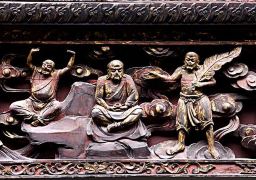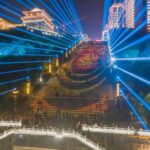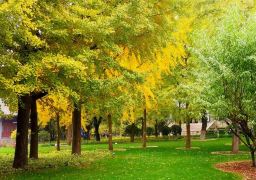The Huguang Guild Hall is located on the side of the ancient Dongshuimen by the Yangtze River in Yuzhong District, Chongqing. It is composed of three major guild halls: the Yuwang Palace, Qi’an Gongsuo, and Guangdong Gongsuo surrounded by high walls. The Chongqing Huguang Guild Hall was built in the Qianlong period of the Qing Dynasty. After continuous reconstruction and expansion from the Qianlong period to the Guangxu period, it has reached its current scale and has a history of nearly 300 years. At the end of 2003, the Chongqing municipal government and the Yuzhong District government invested nearly 200 million yuan to carry out protective restoration of the core area building complex of the Huguang Guild Hall. The restoration was completed in September 2005. The central area of the guild hall covers an area of 18,418 square meters. As a commercial organization in Chongqing (Chongqing) established by foreign officials, gentry, merchants and businessmen during the Kangxi period of the Qing Dynasty, it is an existing ancient guild hall building complex with a large scale and in good condition in China. Three hundred years ago, represented by the large-scale migration movement of ‘filling Sichuan from Huguang’ involving more than a dozen provinces, it forged the broad-minded and resolute, brave, enthusiastic and upright character traits of Chongqing people who are inclusive, open, united and enterprising. The Chongqing Huguang Guild Hall not only preserves the material culture of guild hall architecture, but also condenses the intangible culture of immigrant spirit. In the past, present and future, the Chongqing Huguang Guild Hall is an important cultural symbol that Chongqing people are proud of. The guild hall building is grand in scale, with an orderly layout. The palaces are majestic and spectacular, and the shapes are simple and elegant. It is extremely difficult to survive in the downtown area with many high-rise buildings. It has great historical, artistic and scientific value. The Huguang Guild Hall is also called Yuwang Temple, Yuwang Palace and Chu Temple, dedicated to King Yu to suppress floods. Qi’an Gongsuo is also called Dizhu Palace, dedicated to Dizhu (also known as Fuzhu) to pray for happiness, auspiciousness and peace. Guangdong Gongsuo is also called Nanhua Palace, dedicated to Nanhua Patriarch Huineng. Immigrants from various provinces mainly from Huguang entered Bashu. Various beliefs also entered Sichuan with immigrants, thus forming a unique folk belief pattern in Sichuan area in the Qing Dynasty. During this period, the belief in Dayu in Bashu area also presented a unique phenomenon of ‘produced in Shu and worshipped in Chu’. Since its opening, the Chongqing Huguang Guild Hall has received more than 10 million tourists at home and abroad. It has become a business card of Chongqing city and a monument of Chinese immigrant culture. It enjoys a high reputation at home and abroad. It condenses the awe and pride of Bashu ancestors for Chinese culture. It is an important carrier and proof of the inheritance of Chinese civilization in Bashu land. It is an excellent stage where splendid history and modern culture complement each other. There are tens of thousands of carved artworks such as wood carvings, stone carvings and brick carvings remaining in the guild hall building. All of them are exquisitely carved and amazing. Before the restoration of the guild hall, there were a large number of carvings from the Ming and Qing Dynasties. The themes are mainly patterns of character stories such as Journey to the West, Romance of the Western Chamber, Romance of the Three Kingdoms, Investiture of the Gods and Twenty-four Filial Piety, as well as patterns of dragons and phoenixes, animals and various exotic flowers and plants. It should be a kind of respect for hometown totems by immigrants and is an outstanding representative of southern carving art in the Ming and Qing Dynasties. In 2003, with the support of the National Cultural Heritage Administration, Tourism Bureau, and other departments, experts and teams from Shandong, Shanxi, Shaanxi, Beijing, Sichuan, and other places across the country spent nearly two years restoring and reviving the preserved carving art within the guild hall, allowing it to reappear in the world. The carving works in the hall are diverse in subject matter, beautiful in form, gilded and colorful, and lifelike, offering a beautiful enjoyment with an antique charm, and everywhere revealing the elegant aesthetic cultivation and superb craftsmanship of the ancients. The Huguang to Sichuan Immigration Museum, as one of China’s earlier immigration-themed museums, with the background of ‘Huguang to Sichuan’, displays the historical background, economic factors, and routes of immigration into Sichuan from different perspectives, vividly and comprehensively reflecting the history of ‘HThe East Water Gate city wall was originally built during the Hongwu period of the Ming Dynasty and has a history of more than 600 years. Facing the Yangtze River, it stands alone in the river, naturally perilous, majestic, presenting a typical ancient city wall with mountain city characteristics, and has high architectural science and artistic value. The long history of creation and evolution of the East Water Gate and the city wall records the vicissitudes of the former water dock and the mother city of Chongqing, and also reflects the long history and profound culture of Chongqing. In 2000, it was announced by the Chongqing Municipal People’s Government as the first batch of municipal-level cultural relics protection units after the establishment of the municipality, and in 2013, it was announced as a national key cultural relics protection unit.
It restores the scenes of people from Hunan, Hubei, Guangdong, and Guangxi provinces traveling by water and land into Sichuan, and systematically explains the influx of commercial immigrants, making Chongqing gradually become an immigrant commercial city.
It draws on the strengths of many, innovates, and uses modern multimedia technology, combining sound, light, and electricity technology, and through a series of interactive experience activities, allowing visitors to relive the immigration journey and feel the hardships of their ancestors’ entrepreneurship.

The rich historical and cultural heritage of Chongqing Huguang Guild Hall and the unique ancient architectural forms have attracted many film and television shooting organizations to come for shooting, becoming a popular film and television exterior shooting base. Since its restoration and opening, it has successively provided exterior shooting locations for many films, variety shows, and photography programs such as ‘Wits Battle at Shajiabang’, ‘Paper Drunk and Gold Crazy’, ‘Spy War’, ‘Chongqing 1950’, ‘Quality Bodyguard’, ‘Lu Zuofu’, ‘Eight Minutes of Warmth’, ‘Lie Detector’, ‘Extreme Challenge’, ‘Twelve Flavors’, and ‘New Year’.
Opening hours: July 18th to August 29th, 09:00-22:00; August 30th to September 12th, 09:00-19:00; September 13th to December 31st, 09:00-22:00.

Preferential policies for the elderly: Free for those aged 65 and above with an elderly card or ID card; half price for those aged 60 to 65 (excluding 65) with an elderly card or ID card.
People with disabilities: Free with a disability card.

Military personnel: Free for active military personnel with a military officer card.
Students: Half price for full-time primary, middle, and high school students (excluding adult education graduate students) with a student card.

Service facilities: Parking lot: [Scenic spot parking lot] Reference price: ¥2/hour; Address: Next to Chongqing Huguang Guild Hall; Spaces: 50









